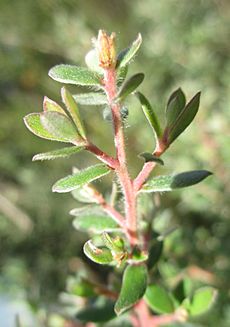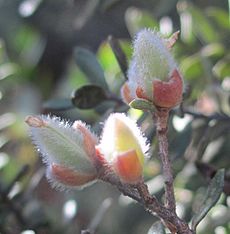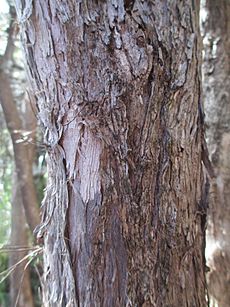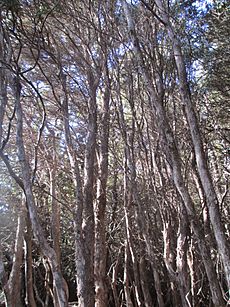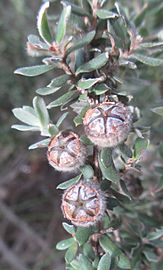Woolly teatree facts for kids
Quick facts for kids Woolly teatree |
|
|---|---|
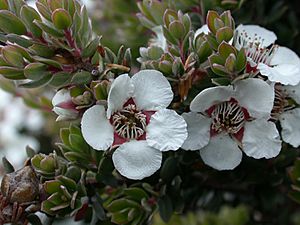 |
|
| Scientific classification | |
| Genus: |
Leptospermum
|
| Species: |
lanigerum
|
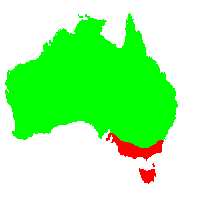 |
|
The Leptospermum lanigerum, also known as the woolly teatree, is a small tree or medium-sized shrub. It belongs to the plant family Myrtaceae. Its common name, "woolly teatree," comes from its very hairy fruits and the soft, silky hairs on its branches and leaves.
You can find the woolly teatree in many different places. It especially likes wet areas. These include moist, sandy coastal areas, river banks, and even some woodlands. This plant is only found in Australia. It grows naturally in New South Wales, South Australia, Tasmania, and Victoria.
Its flowers look like other Leptospermum plants. They have five white petals, many stamens, and five small sepals. But what makes the woolly teatree special are its hairy fruits, called capsules. Its mature leaves also have a silvery look.
The woolly teatree is common across Australia. It grows in the wild and is also planted in gardens. Indigenous Australians have used this plant for many years. Today, it is still a popular plant for gardens.
Contents
What the Woolly Teatree Looks Like
This plant can be a small tree or a medium-sized shrub. It comes in different shapes and sizes. Some plants grow as large, spreading shrubs up to 3 metres (9.8 ft) tall and 3 metres (9.8 ft) wide. Others are very compact and tall, growing up to 3 m high but only 1 metre (3.3 ft) wide. In Tasmania, the woolly teatree can even grow as a slender tree up to 18 metres (59 ft) tall in mountain areas.
Leaves
The leaves usually grow one after another along the stem. They are oblong (oval-shaped) with edges that curl slightly. Leaves can be from 4–20 millimetres (0.16–0.79 in) long. New leaves are often covered in small, soft, silky hairs. These hairs make the leaves look silvery grey. However, leaves can also be dark green or sometimes shiny on top.
Like all plants in the Myrtaceae family, woolly teatree leaves have tiny oil glands. When you crush the leaves, they release a strong, special smell. These oil glands help identify the plant. Scientists also study these oils to help classify different Leptospermum species.
Flowers
The woolly teatree has flowers typical of the Leptospermum group. Each flower has five separate white petals. It also has five small sepals and many stamens. The flowers usually measure about 18mm across. The stamens often grow in groups of seven.
Many flowers appear in late spring or early summer. They can also bloom at other times of the year. Flowers grow at the ends of short side branches. Most of these flowers have both male and female parts. However, the woolly teatree also produces some flowers that are only male.
Fruit
The fruits are called capsules. They are very hairy when they first appear. These capsules usually stay on the tree for a long time. Each capsule has 4–5 sections and is about 5–10 millimetres (0.20–0.39 in) wide. They grow alone on short side branches. This is different from Melaleuca plants, whose capsules grow in clusters along the stem.
These tough, woody capsules protect the seeds from animals or fire. The capsules need extreme dryness or fire to open. This allows the seeds to be released. They then grow in the ash-rich soil after the first rains following a fire.
Bark
The woolly teatree has smooth, light brown bark. It is fibrous and papery. The bark peels off the trunk in long strips. This bark helps protect the trunk and special buds (called epicormic buds) from fire. This means the tree can often grow back even after being burned. Its bark is very similar to other Leptospermum species.
Naming the Woolly Teatree
The name Leptospermum comes from Greek words. Leptos means slender, and sperma means seed. This refers to the very thin seeds of the first Leptospermum plant ever described. The species name, lanigerum, comes from a Latin word meaning "wool-bearing." This describes the silky hairy leaves and fuzzy buds and young fruits. The common names, 'woolly tea-tree' or 'silky tea-tree', also come from these features.
Long ago, in 1789, this plant was first named Philadelphus laniger. Later, a scientist named Sir James Smith moved it to the Leptospermum group. Today, its scientific name is Leptospermum lanigerum.
Plants in the Leptospermum group are often called 'tea-trees'. This name started with Captain Cook's crew. They made a tea from the fragrant leaves in Australia and New Zealand. They thought it would help prevent a disease called scurvy. Sometimes you might see 'ti-tree' written, but this spelling is incorrect. Also, 'Tea tree oil' does not come from Leptospermum plants. It comes from the leaves of a different plant, Melaleuca alternifolia.
Leptospermum is part of the Myrtaceae family. This is a large plant family common in Australia. Other well-known plants in this family include Eucalyptus (eucalypts) and Melaleuca (bottlebrushes). There are 83 species in the Leptospermum group, and 79 of them are found only in Australia.
Where the Woolly Teatree Grows
The woolly teatree is found only in Australia. It mainly grows in the southeastern states. You can find it in eastern South Australia, across Victoria, and in southern New South Wales. It also grows all over Tasmania.
These plants are common and widespread. They mostly grow in wet, swampy areas and along river banks. You can also find them in sandy coastal areas or woodlands. Sometimes, L. lanigerum grows in cool temperate rainforests in western Tasmania. However, it might not be a true rainforest plant. This is because its seeds need disturbances like fire to be released.
This plant is very tough and likes wet places. This makes it useful for restoring riverbanks and stabilizing streams. It thrives in swampy areas where many other plants cannot.
In Tasmania, the woolly teatree is a key plant in swamp forests. These forests grow in flat, poorly drained places. They have a dense tree canopy made of tough-leaved plants like Leptospermum, Acacia, and Melaleuca. In Tasmania, L. lanigerum can form tall, dense stands up to 18m high. In other Australian states, these plants are usually shorter, thick shrubs.
While mostly found in low areas, some woolly teatrees also grow in high mountain areas. They can be found along the edge of mountain grasslands. The woolly teatree is an adaptable plant. It can grow in different directions and soil types. Even though it prefers wet areas, it can also grow well in drier soil.
How the Woolly Teatree Lives
Fire and Life Cycle
The woolly teatree has a special relationship with fire. Like many plants in the Myrtaceae family, its seeds are held inside woody capsules. These capsules often stay on the tree for years after the seeds are ready. To be released, the capsules need fire or another disturbance. After a fire, the ash-rich soil and some rain create good conditions for the seeds to sprout. The fire's heat is important; too much heat can destroy the seeds and capsules.
Trees can also grow back after a fire. This is because they have special underground stems (lignotubers) and buds (epicormic buds) protected by their thick bark. Sometimes, in dense groups of trees, fire only burns the main branches. The underground parts and protected trunks survive. As plants grow back after a fire, other species can fill the open spaces. This leads to a mix of tea-trees, cutting grass, and plants like Bauera.
Pollination
Leptospermum plants are pollinated by insects, usually beetles. Each flower has sweet nectar in its center. This nectar attracts beetles. The beetles then carry pollen on their bodies to other flowers. The nectar and insects also attract birds. This makes Leptospermum plants popular for gardens.
Seed Dispersal
The seeds of the woolly teatree do not spread very far. They usually fall to the ground after a fire. Seeds can also be spread by wind or water. Sometimes, insects like ants carry them. However, ants can also eat the seeds while they are still in the capsules on the plant. The woolly teatree is one of the Leptospermum species most affected by ants eating its seeds.
Diseases and Pests
The woolly teatree might be very vulnerable to a plant disease called Phytophthora ramorum. This disease causes a lot of damage to gardens and natural areas in America and Europe. It is not yet in Australia. However, experts think it could cause big problems if it arrives there.
Some insects also cause problems for the woolly teatree. The Webbing Caterpillar damages many young Leptospermum plants. It uses silk to stick leaves together and leaves droppings inside. Scale insects can suck sap from stems and leaves. They also produce a sticky substance that causes a black mold (sooty mould) to grow on the leaves.
Growing the Woolly Teatree
The woolly teatree is an adaptable plant. It can grow in most soil types and conditions. People often grow new plants from seeds or cuttings. They are sold in nurseries for garden use. This plant is popular in gardens because of its pretty flowers and its ability to grow in many places.
There are three main forms of the plant:
- A large, spreading or upright shrub up to 3 m tall and 3 m wide.
- A compact, tall shrub up to 3 m tall and 1 m wide.
- A slender tree up to 18 m tall (found only in Tasmania).
History and Uses
The woolly teatree was the first Leptospermum species to be grown in gardens. This happened in March 1773. Captain Tobias Furneaux collected seeds from Adventure Bay, Tasmania. This was during Captain James Cook's second trip to the South Seas. These seeds were then grown at the Royal Botanic Gardens, Kew in 1774.
Indigenous Australians used the woolly teatree for many things. They made kangaroo spears and double-barbed spears from its wood. Young shoots and stems from many Leptospermum species were also used as medicine to treat urinary problems.
Even though it's not common today, early European settlers used many Leptospermum species as a tea substitute. Captain Cook's crew also brewed tea from these plants. They believed it would help prevent diseases like scurvy.


